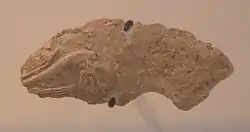Helodermoides
Helodermoides is an extinct genus of anguid lizards from the Oligocene of North America. The genus is monotypic, including only the species Helodermoides tuberculatus. Helodermoides belongs to an extinct subfamily of anguids called Glyptosaurinae. In addition to many fragmentary bones, several complete skeletons of Helodermoides are known. Like other glyptosaurines, Helodermoides was covered in small scale-like bones called osteoderms. The osteoderms covering its skull are hexagonal, tightly interlocking, raised, and rounded.[1]
| Helodermoides Temporal range: Oligocene | |
|---|---|
 | |
| Fossil of Helodermoides tuberculatus | |
| Scientific classification | |
| Kingdom: | Animalia |
| Phylum: | Chordata |
| Class: | Reptilia |
| Order: | Squamata |
| Family: | Anguidae |
| Clade: | †Glyptosaurini |
| Genus: | †Helodermoides Douglass, 1903 |
| Type species | |
| †Helodermoides tuberculatus Douglass, 1903 | |
One fossil of Helodermoides preserves a fused mass of osteoderms at the tip of a shortened tail, thought to represent healing after the end of the tail fell off. The tail would not have been able to grow back because the osteoderms formed a thick bony cap preventing growth. The ability to lose a tail, called autotomy, is also present in living anguids.[2]
References
- Sullivan, R. M. & Augé, M. (2006). "Redescription of the holotype of Placosaurus rugosus Gervais 1848–1852 (Squamata, Anguidae, Glyptosaurinae) from the Eocene of France and a revision of the genus". Journal of Vertebrate Paleontology. 26: 127–132. doi:10.1671/0272-4634(2006)26[127:ROTHOP]2.0.CO;2. JSTOR 4524542.
- Sullivan, R.M. (1979). "Dermal armor pathology in the tail of a specimen of the fossil lizard Helodermoides tuberculatus". Herpetologica. 35 (3): 278–282.